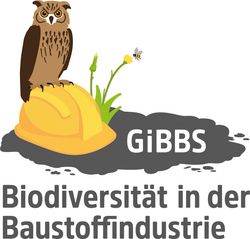Holistic Biodiversity Management in Construction Materials Industry (GiBBS) Strategies and Measures for Biodiversity Protection in Context of Resource Extraction, project phase 2
The project of the BMBF Research Initative for the Conservation of Biodiversity (FEdA), which was preceded by a one-year conception phase, aims to preserve and promote biodiversity in the extraction sites of the building materials industry. The bulk raw materials gravel, sand, clay and gypsum are needed for the production of building materials. According to the Federal Environment Agency, they account for the lion's share of non-renewable raw materials: 517 million tonnes (in 2015) out of a total of 769 million tonnes. Their extraction is associated with considerable interventions in ecosystems.
Extraction sites as ecological niches
Nevertheless, extraction sites can provide special ecological niches and thus habitats for pioneer species and specialists that have become rare in Germany. This applies to both during operation and after the end of raw material extraction. In the case of immigration and/or occurrence of such species in extraction sites that are not listed in existing extraction permits, the Federal Species Protection Act applies, such as the prohibition of killing or the protection of reproduction and resting sites. This can lead to permits being suspended and companies having to interrupt their operations. Many companies avoid this conflict by preventing valuable biotope structures from being created in the first place through so-called "preventive maintenance / upkeep".
Biodiversity Management: Systematic Monitoring and Citizen Science Approach
Where natural areas are irreversibly destroyed by raw material extraction, we investigate how ecological potential can be promoted during the extraction process. We also want to provide impulses for the highest possible quality of subsequent use of the extraction sites. Preventive maintenance should become unattractive. To achieve this, we want to offer companies a better understanding of how biodiversity develops on their sites. A central component of biodiversity management is therefore systematic monitoring, which can be used to assess the quality of biodiversity-promoting measures. With the systematic involvement of nature observers via the naturgucker.de platform, the project expands the method mix for monitoring with a citizen science approach and thus promotes the integration of interested citizens in the events at mining sites.
Adaptation of the legal framework
Surveys conducted during Phase 1 of this project have shown that companies base their technical requirements for biodiversity management and monitoring primarily on the requirements of the licensing authorities, which nevertheless vary from state to state. However, companies should not (have to) perceive each extraction site as a new project, but should be able to operate with standardized requirements. Such a consistent management practice across different sites, however, is difficult to implement without adapting the legal framework. Together with companies and their associations, as well as environmental authorities and nature conservation associations, issues relating to the standardization of requirements for companies and good practice in biodiversity management of raw material mining companies are to be discussed and agreed upon.




